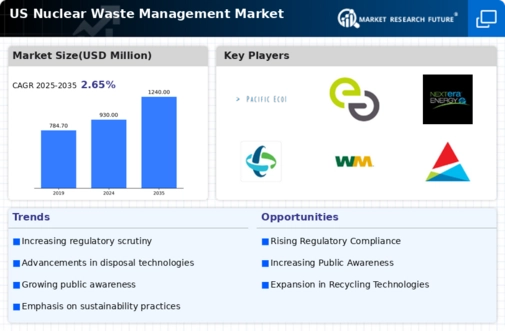Technological Innovation
Technological innovation plays a pivotal role in shaping the nuclear waste-management market. Advances in waste processing technologies, such as pyroprocessing and deep geological repositories, are revolutionizing how nuclear waste is managed. These innovations not only enhance safety but also improve efficiency in waste disposal. For instance, the implementation of advanced robotics in waste handling has shown to reduce human exposure to radiation. The market for these technologies is projected to grow at a CAGR of 5.5% through 2030, indicating a robust demand for innovative solutions. As companies seek to adopt these technologies, the nuclear waste-management market is likely to expand, driven by the need for safer and more efficient waste management practices.
Sustainability Initiatives
Sustainability initiatives are increasingly influencing the nuclear waste-management market. As environmental concerns gain prominence, stakeholders are focusing on sustainable practices in waste management. The push for reducing carbon footprints and promoting recycling of materials has led to the exploration of alternative waste management strategies. For example, some companies are investigating the feasibility of reprocessing spent nuclear fuel, which could potentially reduce the volume of high-level waste. This shift towards sustainability is expected to drive investments in research and development, with an estimated $500 million allocated for sustainable waste management projects in the coming years. Consequently, the nuclear waste-management market is likely to evolve, aligning with broader environmental goals.
Investment in Infrastructure
Investment in infrastructure is a critical driver for the nuclear waste-management market. The aging nuclear facilities in the US require substantial upgrades to ensure safe waste management practices. According to the Department of Energy, an estimated $20 billion is needed over the next decade to enhance waste storage and disposal facilities. This investment not only addresses safety concerns but also supports the development of advanced technologies for waste processing. As public and private sectors collaborate to fund these infrastructure projects, the nuclear waste-management market is likely to see a surge in demand for innovative solutions that can efficiently manage and mitigate the risks associated with nuclear waste.
Regulatory Compliance Pressure
The nuclear waste-management market is experiencing heightened pressure from regulatory compliance requirements. Federal and state regulations mandate stringent protocols for the handling, storage, and disposal of nuclear waste. The Nuclear Regulatory Commission (NRC) oversees these regulations, which are designed to protect public health and the environment. As a result, companies operating in this market must invest significantly in compliance measures, which can lead to increased operational costs. In 2023, the estimated compliance costs for nuclear facilities reached approximately $1.5 billion, reflecting the financial burden of adhering to these regulations. This compliance pressure drives innovation and investment in more efficient waste management solutions, thereby propelling growth in the nuclear waste-management market.
Public Health and Safety Concerns
Public health and safety concerns significantly influence the nuclear waste-management market. The potential risks associated with nuclear waste, including contamination and radiation exposure, have led to increased scrutiny from communities and advocacy groups. In response, companies are compelled to adopt more transparent practices and invest in advanced safety measures. Surveys indicate that approximately 70% of the public expresses concern over nuclear waste management, prompting stakeholders to prioritize safety in their operations. This heightened awareness drives demand for more effective waste management solutions, thereby fostering growth in the nuclear waste-management market as companies strive to address these concerns.



















Leave a Comment